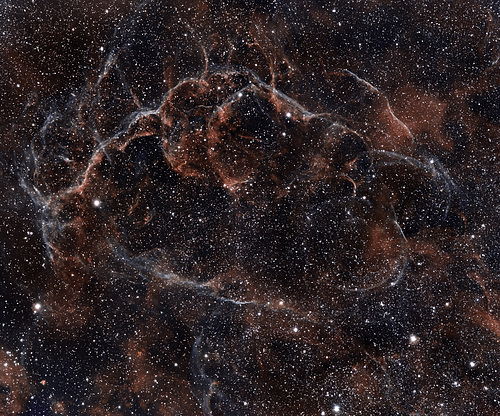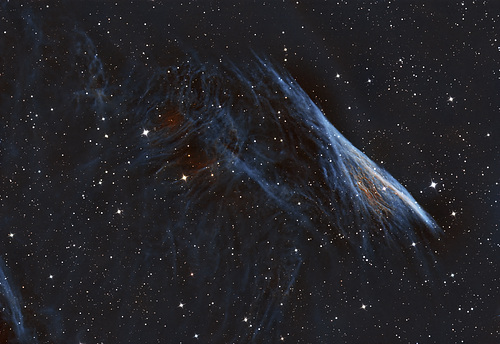

The Filaments was formed by the Super Nova explosion the remnants of that explosion. Even the pencil nebula is a part of the explosion.

This is a very small part of the whole area as its end of season for this part of the sky no way I could do a whole panorama. The Blue is Oxygen that in the two shots above you can see as white Filaments. What you are looking at is in the bottom wide field of the area just below the large Left big nebula you can see just below but this shot is rotated. This whole area has some great targets for next year, this was some thing I was looking forward to being able to do with the filters as I knew the blue stood out.
QHY268M -10c 120 Odd shots 5 min each filter over 6 nights .. 30 shots each RGB 1 min exposure.
QHYCFW3 and 7 Antlia filters LRGBSHaO
MeLE Mini PC
Pegasus Astro Pocket Mini power box
Starpoint Australis SP3 Focuser Rotated 22 degrees from last
Skywatcher 200 F4 PREMIUM PHOTO QUATTRO REFLECTOR OTA
Skywatcher F4 Aplanatic Coma Corrector
Skywatcher NEQ 6 Pro Hypertuned
SVbony 50MM Guide scope
QHY5L-II-M Guide camera
Guided PHD2, Nina
Pixinsight, Ps, Lr



23 comments
Marek Ewjan Stachows… said:
→ have a good weekend, Steve!
Steve Paxton replied to Marek Ewjan Stachows…:
David G Johnson said:
Steve Paxton replied to David G Johnson:
When you consider there is 120 x3 filters shots 360 shots that make up the background and there is 30 x3 filters shots for the stars 90 shot making a total of 450 shot to make the single shot you see above all stacked together so that can make a final image . Why so many, to get the detail in the shot plain and simple, a total of 30 shot has the basic shape but none of the intricate detail you see above. A gnat would not even cause a ficker but clouds and planes do cause a problem let alone satellites.
There are some very smart people out there that worked all this out I just use the programs to my advantage. We are also blessed with clear skies so are able to do this. This area I will come back to next year as its getting too high in the sky for a nights shooting. I hope you get to come back and read this as it all makes sense once you know how the system works.
David G Johnson replied to Steve Paxton:
To sum up would it be true to say that > Staying on target via 'Plate solving' means the system recognises the previous images - and kind of re-''locks on''' to the image (as you quote 'checked against the original plan/ pattern) and continues the process or programme set up into your system ?
Thanks again Steve,.. keep up your brilliant work,.. and Cheers'.. from Dj.
Stephan Fey said:
Steve Paxton replied to Stephan Fey:
William Sutherland said:
Steve Paxton replied to William Sutherland:
Diana Australis said:
Steve Paxton replied to Diana Australis:
Steve Paxton replied to David G Johnson:
Xata said:
Guess you have a lot of work done and gear to perform such wonders, you could publish on astronomical magazines also on Nat Geo !
Steve Paxton replied to Xata:
Even my two images totally put the book to shame so I did not keep it. I get a lot of enjoyment out of this and I know it will never be mastered by Ai.
tiabunna said: